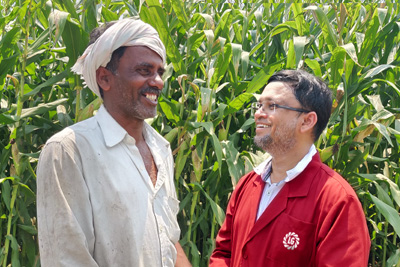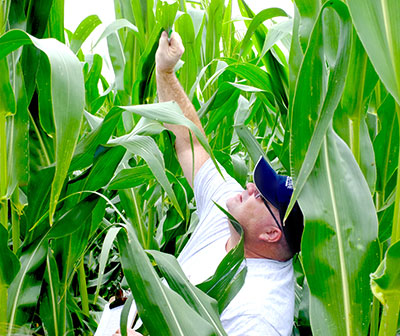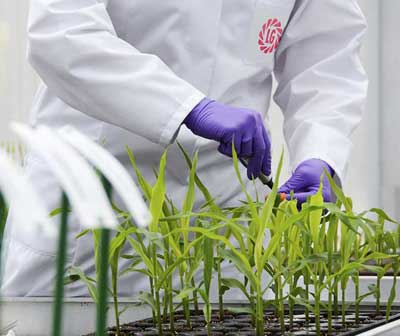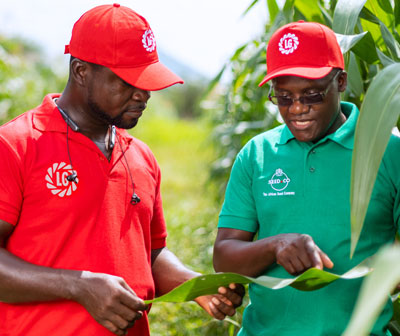Plant Reproduction : researchers unravel the role of new membrane within pollen grain.
Friday 30th July 2021
While the reproduction process of flowering plants has been known for more than 120 years, there still remain many mysteries to unravel. Researchers from INRAE, ENS de Lyon, CNRS and Limagrain characterised a new membrane within pollen grain that surrounds the two sperm cells. In a publication in Journal of Cell Biology on 29 July 2021, the scientists show that this membrane is key to guarantee that the male reproductive cells remain intact during their journey toward the female flower, to ultimately form a viable seed. These seeds provide the major food source for humankind as well as staple food for livestock feed. This basic knowledge may be useful for the development of new plant varieties.
The birth of an individual starts with fertilisation: the fusion between a female and a male cell. Unlike animals, where a single fertilisation event is necessary to create an embryo, flowering plants require a double fertilisation event where two male reproductive cells fuse separately and simultaneously with two female reproductive cells. This double fertilisation is indispensable to form a viable seed. These seeds provide the bulk of our plant-based diet as well as feed for livestock.
In flowering plants, the two male sperm cells are not motile, and therefore depend on pollen grain to transport them to the maternal tissues embedded within the flower. In this new study, scientists from INRAE and their coun terpar ts1 revealed a new membrane within the pollen grain that surrounds the two sperm cells, which is important to ensure sperm cell integrity during their journey toward the female flower.
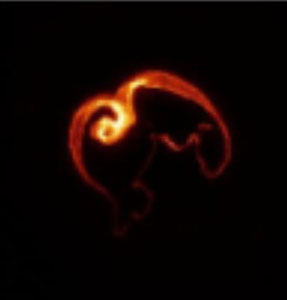
Image of the NOT-LI KE-DAD protein on the membrane that encircles the two ma le sperm eelIs present in each pollen grain (image taken by confocal microscopy).
A key membrane that reveals its secrets... including the presence of a "NOT-LIKE-DAD" protein.
Thanks to microscopy technology and molecular and cellular biology tools, distinctive hallmarks of this membrane have been brought to light.
The first distinctive hallmark of this membrane is enrichment for a specific negatively-charged lipid. The second hallmark is the presence of a NOT-LIKE-DAD protein that has a stretch of positive charges, together with lipid anchors that allow NOT-LIKE-DAD to attach exclusively to this atypical membrane. The researchers also showed that this membrane encircling the two sperm cells plays a key role in making double fertilisation go smoothly, ensuring that the two reproductive cells end up in the right place at the right time.
The discovery of a universal mechanism in the plant kingdom?
On the one hand, these discoveries enrich our knowledge of living organisms. Indeed, other specific membranes, like those that surround some parasitic and symbiotic fungi, have also been found to have a lipid signature similar to that found in pollen grain. This suggests that this kind of membrane may be a universal mechanism to delineate particular structures inside plant cells. On the other hand, the specific localisation of the NOT-LI KE-DAD protein on this particular membrane is a first step in shedding light on the mechanism by which the absence of this protein leads to degraded paternal chromosomes within the enclosed male reproductive cells. This phenomenon is routinely used to develop new varieties of maize, and may also boost plant breeding for many other species.
Reference
L.M. Gilles, A.R.M. Calhau, V. La Padula, N.M.A. Jacquier, C. Lionnet, J.-P. Martinant, P.M. Rogowsky, T. Widiez, Lipid anchoring and electrostatic interactions target NOT-LIKE-DAD to pollen endo-plasma membrane, Journal of cell Biology, 29 July 2021 https://doi.org/10.1083/jcb.202010077
Scientific contact:
Thomas Widiez - thomas.widiez@ens-lyon.fr
RDP lab (Laboratoire Reproduction et Developpement des Plantes},
ENS de Lyon, CNRS, INRAE
Plant Biology and Breeding Research Division
Lyon-Grenoble-Auvergne Rhone Alpes INRAE Centre
Press contact:
INRAE press services: +33 (0)14275 91 86 - presse@inrae.fr
About CNRS
The French National Centre for Scientific Research (CNRS) is one of the most recognised and renowned public research institutions in the world. For more than 80 years, the CNRS has excelled in recruiting experts and carrying out multi- and inter-disciplinary research in all of France, Europe and the world. The Centre places the common good at the heart of the matter, fostering scientific, economic, social and cultural progress in France. The CNRS is first and foremost a family of 32,000 women and men working in 200 professions. Overall, more than 120,000 people work in its 1,000 laboratories, most of them shared with universities, schools and other research bodies. Together, they push the boundaries of knowledge by exploring living organisms, matter, the Universe, and how human societies function. The close link between the Centre's research and concrete transfers to society places the CNRS squarely at the forefront of innovation; its partnerships with the corporate world are the basis of its technology transfer policy. The CNRS houses more than 150 joint structures with industrial players and helps create about 100 start-ups a year, which speaks volumes about the economic potential of its work. Research data from the CNRS is open and accessible to all. This knowledge-sharing is geared toward several audiences: scientific communities, the media, decision makers, economic players and society at large.
For more information visit www.cnrs.fr
About ENS de Lyon
In the tradition of French excellence in higher learning, the Ecole Norma le Superieure (ENS) de Lyon is a university that trains future teachers and researchers in academia through fundamental research. All fields of study are included, except medicine and law. ENS de Lyon has also become a reference for educational sciences. Its campus, open to the world, boasts some sixty nationalities.
Students at ENS de Lyon build an individualised course of study by means of a study contract. They benefit from an exceptional staff-student ratio with some 600 teacher-researchers, as well as an initiation into research in the school's 30 laboratories and platforms.
http://www.ens-lyon.fr/
About Lirnagrain
Limagrain is an agricultural cooperative owned by some 1,500 farmers in Limagne Val d'Allier (central France) and an international seed group present in 57 countries with more than 9,000 collaborators. The group breeds, produces and markets field seeds, vegetable seeds and agrifood products. Focused on the genetic progress of plants, Limagrain has one guiding principal: cooperate for the progress of agriculture everywhere, for everyone. The world's fourth largest seed company, Limagrain has sales figures of €1,909M thanks to recognised brands like LG, Vilmorin, Hazera, Harris Moran, Jacquet and Brossard. An additional €642M is achieved thanks to business carried out jointly with strategic partners
www.limagrain.com
#Limagrain
- Scientists from the joint RDP lab (Reproduction et Deve!oppement des P!antes, ENS Lyon/CN RS/1NRAEt Limagrain Field Seeds research centre (Limagraint and the Centre techno!ogiques des microstructures(Universite Claude Bernard Lyon1) participated in the study.

